This post may contain affiliate links. We may receive a small commission, at no cost to you, if you make a purchase. Read Disclosure.
We love the city of Florence. It’s one of the most enchanting, beautiful, and artfully rich cities in Italy and the perfect place to spend a couple of days before heading to the rolling hills of Tuscany.
We get a lot of people asking us about how to maximize their time in Florence, especially as they only have 2 days to spare.
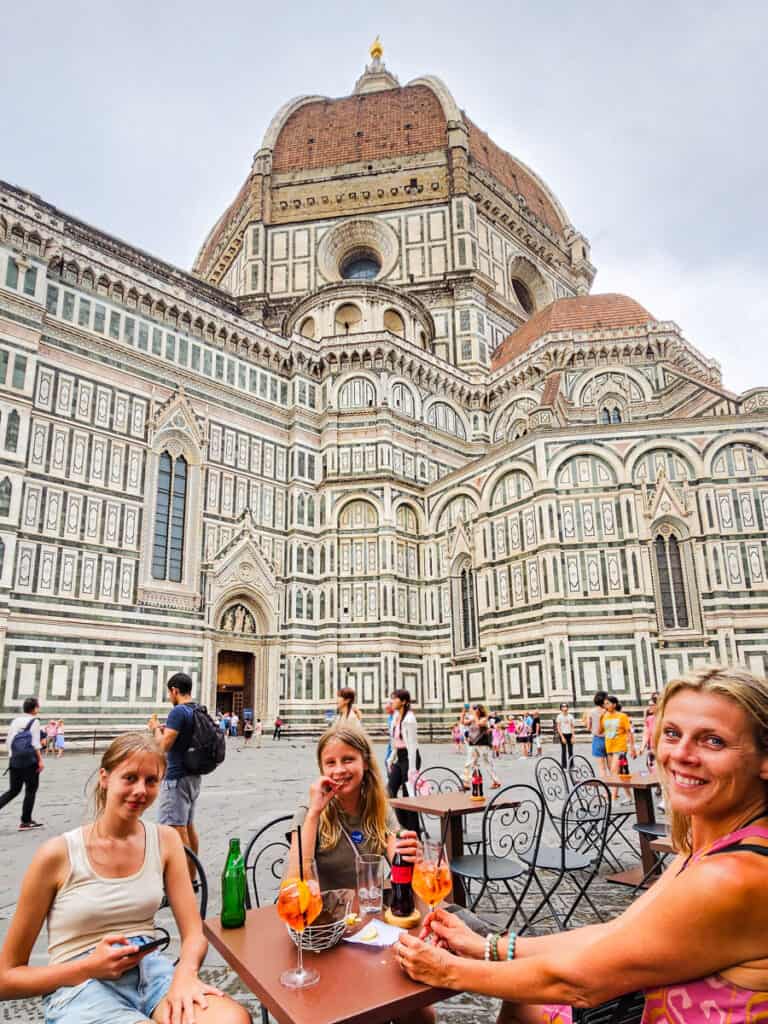
I get it, with so many amazing cities and destinations in Italy to visit, sometimes our itineraries only allow a couple of days and it can be a hard task knowing how to fit all the top attractions and highlights in.
Don’t worry, you can see a lot of Florence on a 2 day trip, including some of the most iconic sites; The Statue of David, The Pitti Palace, and the Uffizi Gallery, to name a few.
If you’re not sure where to go and what to see in Florence over 48 hours, then don’t worry, as we’ve put together our best 2 day Florence itinerary so you can see the best of this amazing city.
Is 2 days enough for Florence?
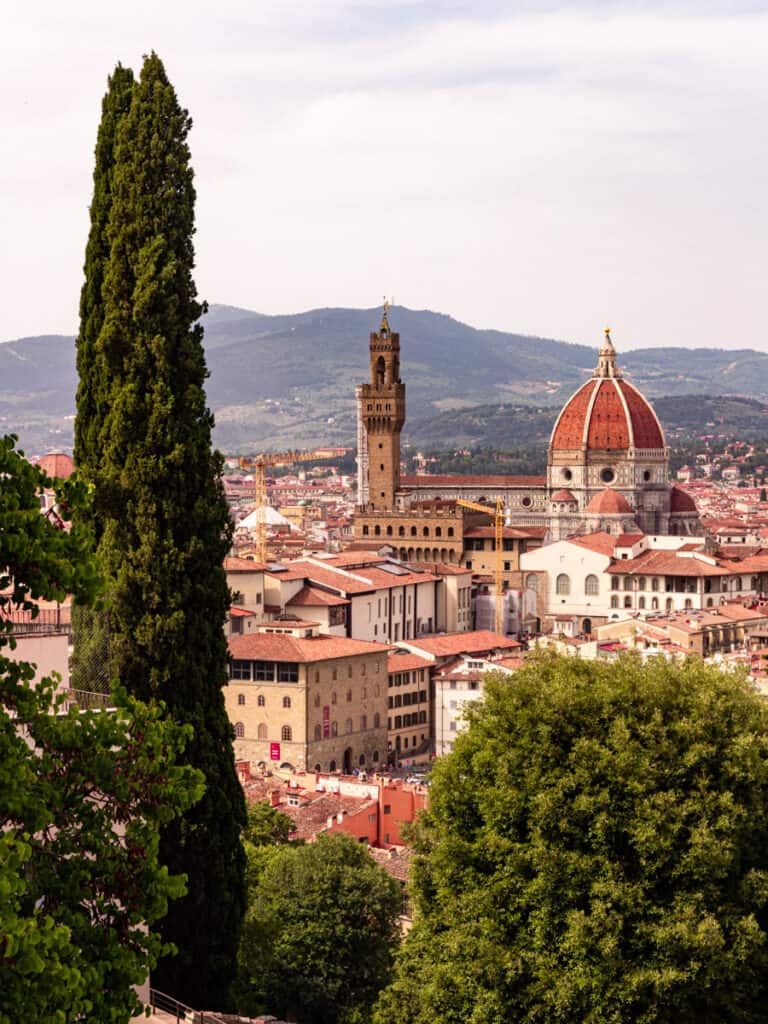
Before I get into this 2 day itinerary, you might be wondering if two days are long enough to see Florence. Two days is the minimum amount of time you need in Florence to see the highlights, but ideally, the three days would be better.
The reason for this is that there are a lot of museums and art galleries in Florence that are worth seeing, and many of them take a few hours to get around.
The Uffizi Gallery, for example, is packed with some of the most renowned pieces of Renaissance paintings in the world. It’s a gallery you could spend a full day in, and not see it all.
In two days, you can still visit these museums and galleries, but your visit will be cut short. You could maximize your time by getting a guided tour or audio guide, but you still might feel that your visit is a bit rushed.
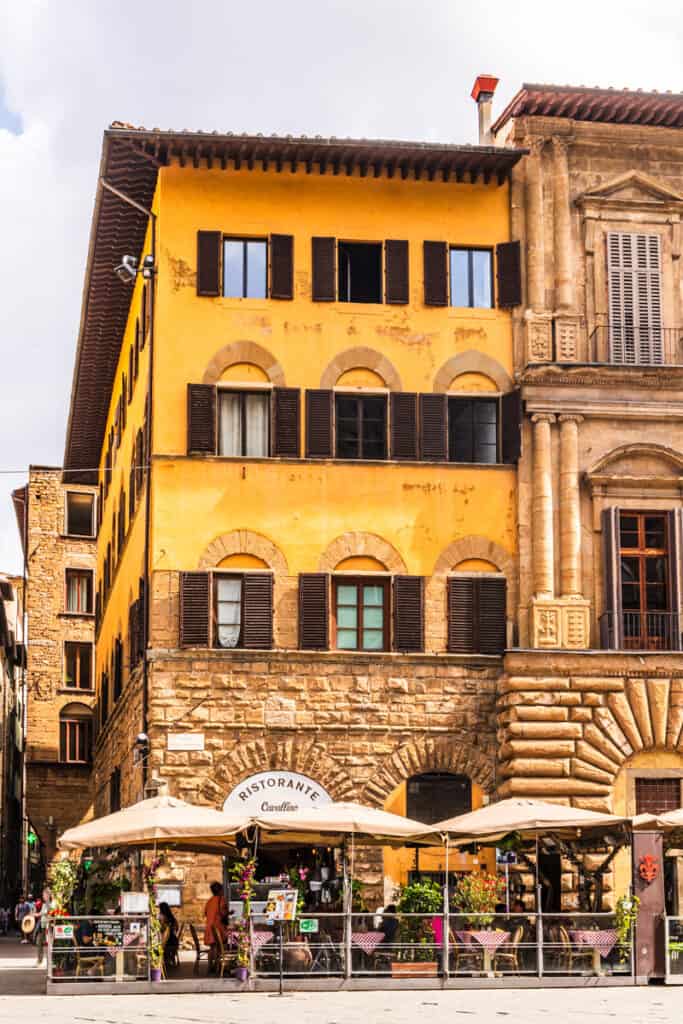
To make sure you make the most of a two-day trip to Florence, this guide will take you to the places in Florence I would suggest seeing, and in an order that allows you to make the most of your time.
If you follow this 2 day itinerary of Florence, you’ll get to see the main sites of Florence, such as the Duomo, Ponte Vecchio, and Gallerie Acadamia to see the Statue of David, as well as see some of the most vibrant neighborhoods to get a feel for local life in Florence.
If you have more time or plan to come back, then you can explore the same attractions we’ve mentioned below, but take your pace more leisurely so you can spend more time there!
The Best Florence Itinerary For 2 Days
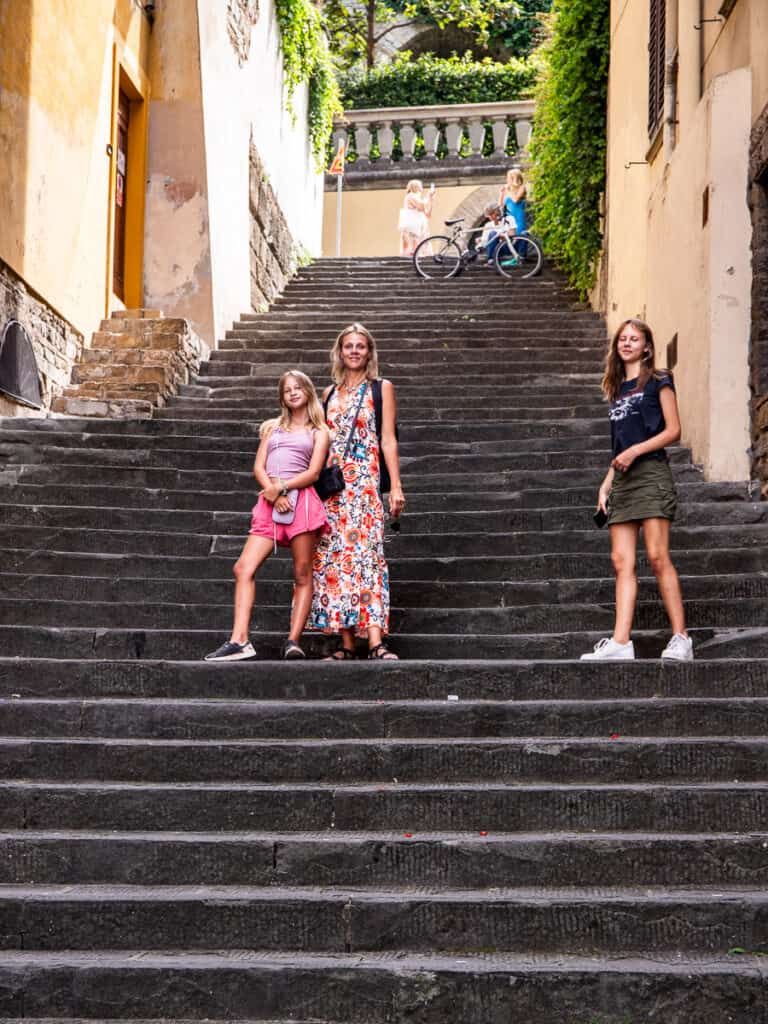
The following itinerary is how I would suggest spending two days in Florence. It’s not set in stone, and you can take out places that don’t interest you or swap attractions around based on where you decide to stay.
Use it as a guide and adjust it to suit your needs, time frame, and budget.
The first day explores the Oltrarno Neighborhood. This is a bohemian, quirky neighborhood full of winding alleyways, quaint little coffee shops, boutique stores, and bars.
It’s where you’ll find many of Florence’s most iconic attractions, such as The Basilica di Santo Spirito and the Palazzo Pitti.
The Oltrarno neighborhood has culture, relaxing nature, and impressive historic monuments. You can read more about how to spend a day in the Oltrarno Neighborhood in our complete guide to the district.
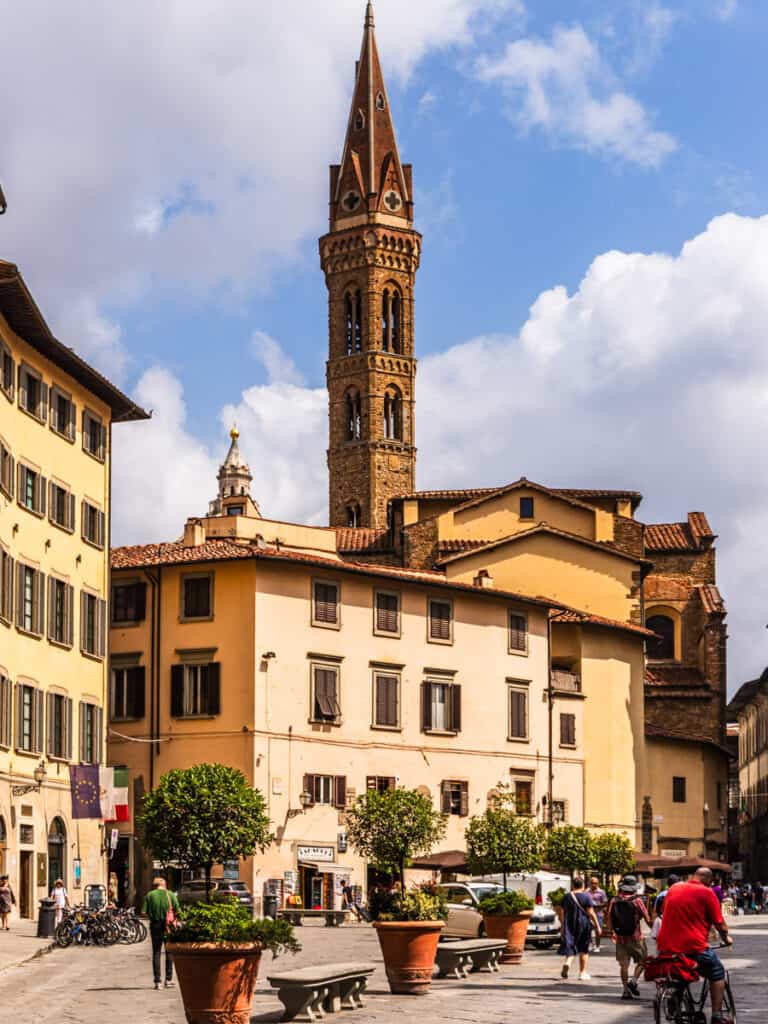
The second day features the biggest attractions in Florence such as The Duomo and Uffizi Gallery on the other side of the river, which is the most touristic area.
You might want to swap the days around, depending on what you’re most excited to see. I really enjoyed visiting Oltrarno on our first day and seeing Florence from that perspective. I think if I did the other side first I would have been over and underwhelmed!
Day 1
Stop 1: Boboli Gardens
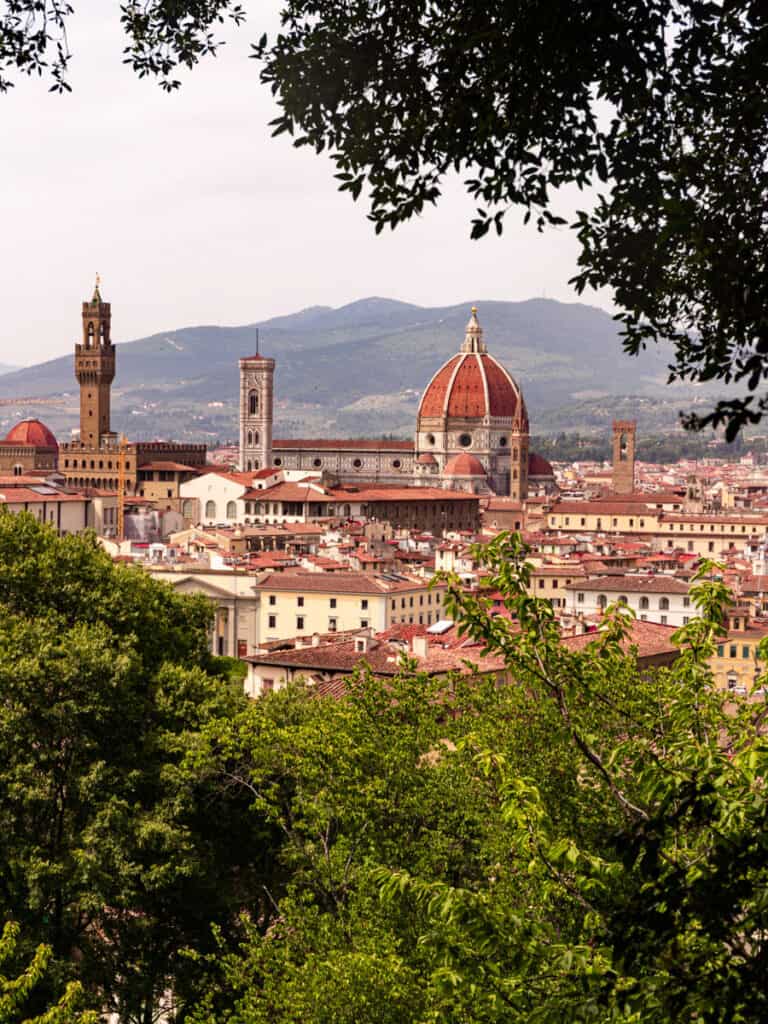
If your first impression of Florence is that it’s a little more crowded and bustling than what you’re used to, then you might want to ease yourself into the Florentine way of life by visiting the relaxing and historic Boboli Gardens.
Located across the Arno River, the Giardino di Boboli is a beautiful, English-style garden on a hillside that was built by the Medici Family (you’ll hear a lot about them in Florence).
The gardens date back to 1418 but have evolved over the centuries by generations of the Medici family and the Savoy family, who bought it from the Medicis. The park is the finest example of Renaissance landscaping and features manicured lawns, ornately designed fountains, and tree-lined paths.
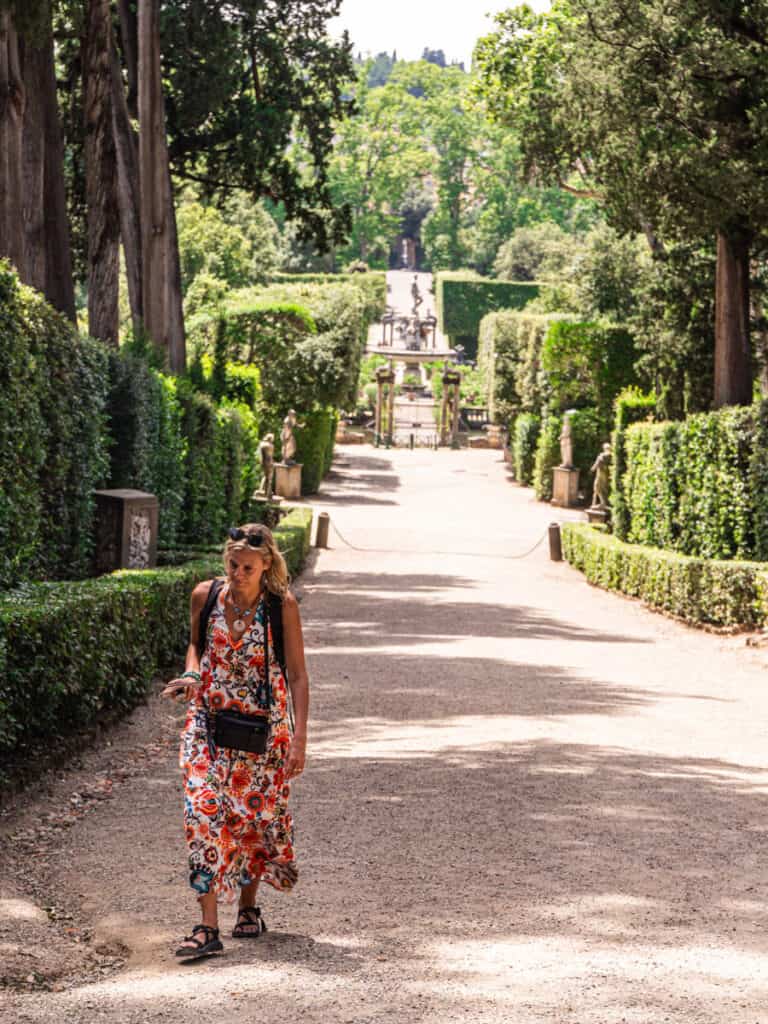
The relaxing ambiance and stillness are the perfect vibe to start your trip to Florence. We entered from the Piazzale di Porta Romana, the southernmost gate, so we could witness the Viottolone, a famous sloping pathway framed by cypress trees.
Even more beautiful was arriving at the top for views over Pitti Palace and Florence.
Stop 2: Villa Bardini Gardens
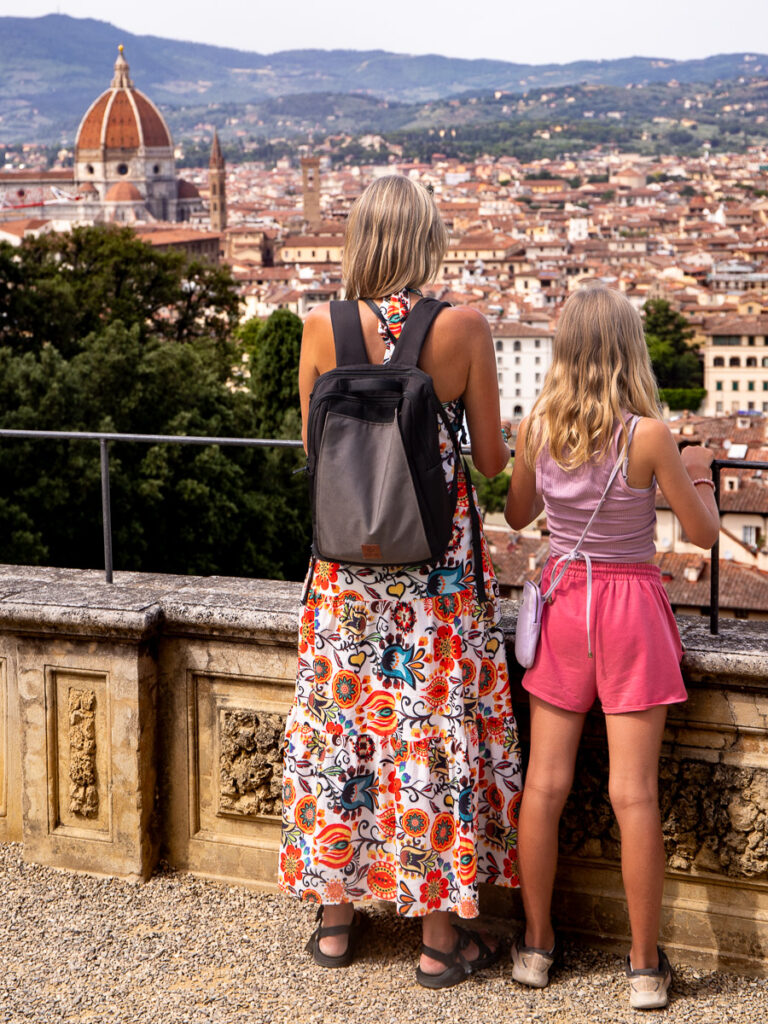
Just across from the Boboli Gardens are the Villa Bardini Gardens, which are much smaller but no less beautiful.
It’s a beautiful park to visit in the Spring and is full of colorful flowers and Renaissance architecture.
There’s a wonderful terrace bar at the top where you can catch amazing views of the city with a hot espresso, or an aperol spritz in the afternoon like we did, They even serve food here. It was one of my favorite views in Florence.
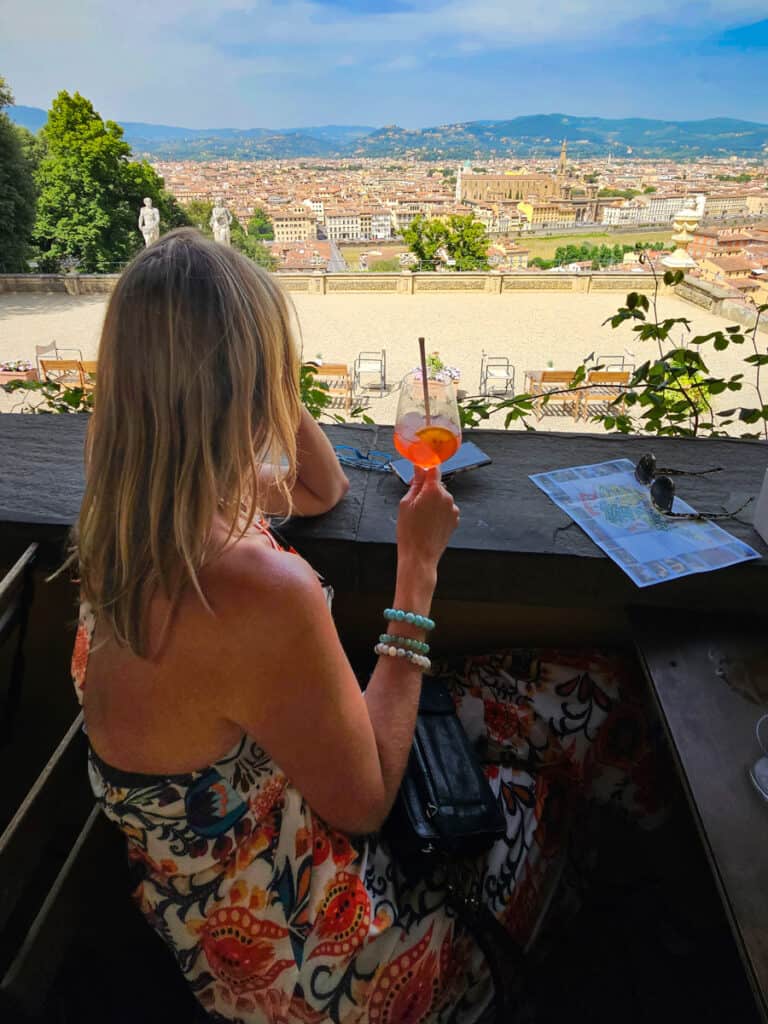
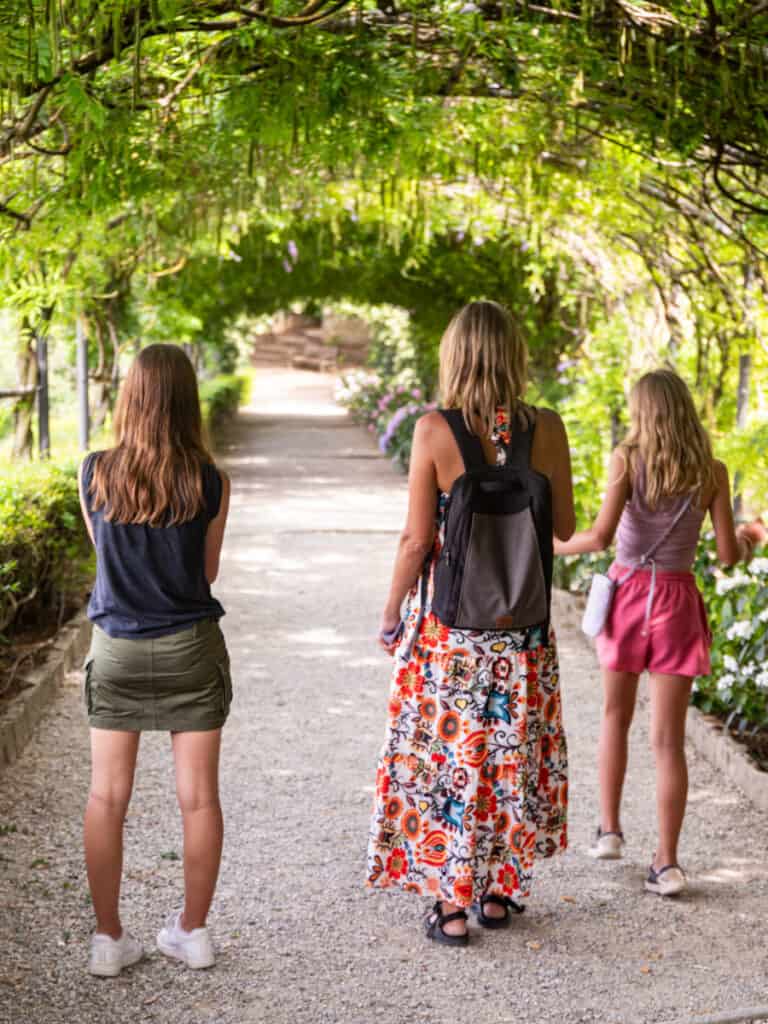
Right near here is also the Wisteria tunnel, which is beautiful to walk through. It’s super popular at the end of April when the wisteria is in full bloom. Imagine walking down this beautiful floral tunnel of violets and pinks with a fantastic panoramic view over the city.
Your ticket to the Boboli Gardens also gives you access to Villa Bardini Gardens.
Stop 3: Pitti Palace
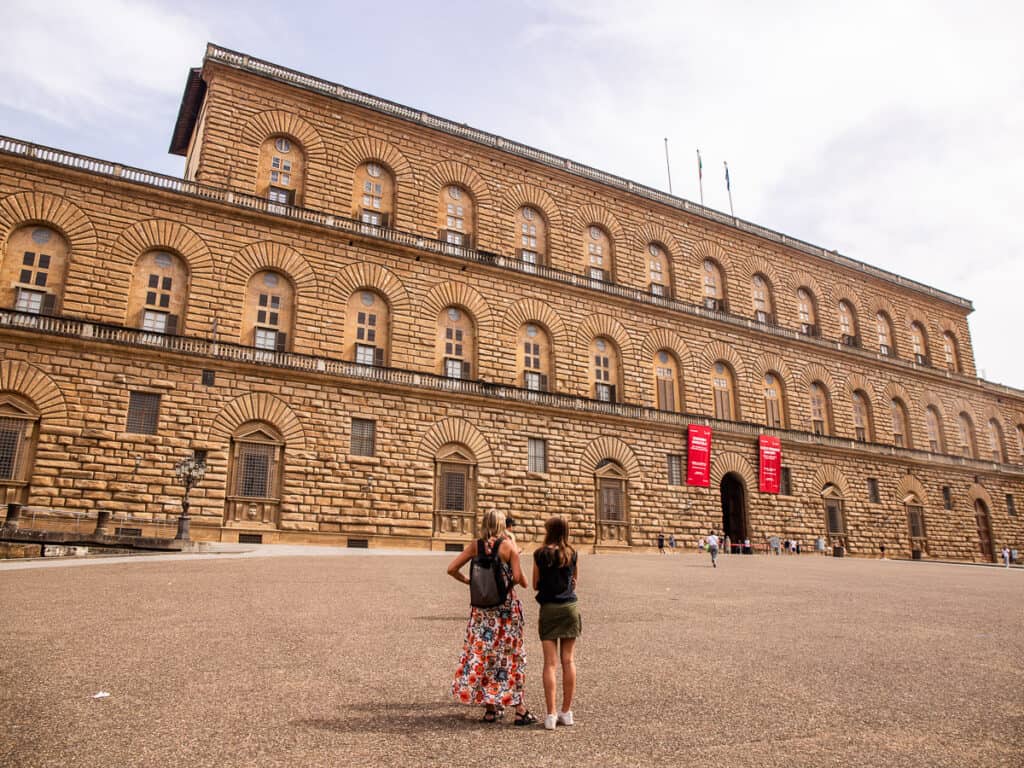
The Pitti Palace, or Palazzo Pitti in Italian, is Florence’s largest palace that was once owned by the Medici family.
From the outside, it doesn’t look like much – the architecture doesn’t wow you as much as the other buildings in the city, but don’t let the facade fool you!
On our best of Florence walking tour and learned that Eleonora di Toledo, the Spanish wife of Cosimo I de Medici, bought the Pitti Palace because she found Palazzo Vecchio quite dull. So there must have been something about it that impressed her.
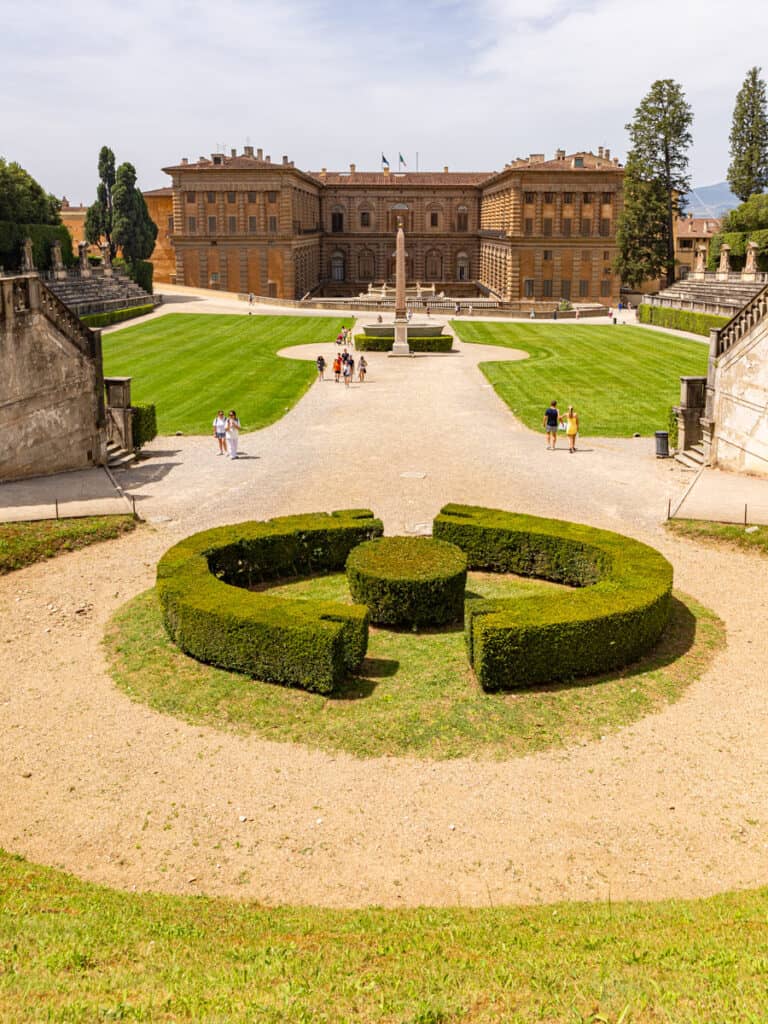
On the inside, it’s home to five different museums, including the Treasury of the Grand Dukes, the Palatine Gallery, the Imperial and Royal Apartments, and the Palatine Chapel on the ground floor.
Get your tickets in advance for Pitti Palace here.
Stop 4: Ponte Vecchio
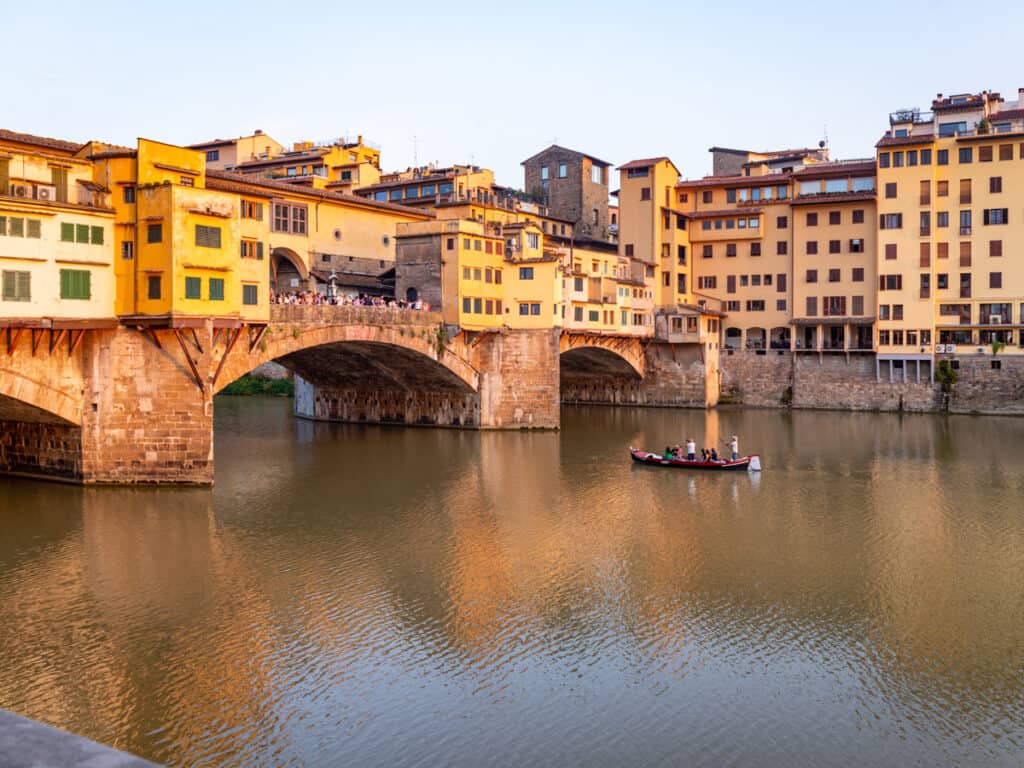
Nothing says “I’ve been to Florence” more than a picture from the Ponte Vecchio, an iconic old bridge crossing the Arno River that was built during Roman times.
The Ponte Vecchio is unique in that it is made up of three segmental arches and lined with overhanging buildings.
The buildings were traditionally used as shops, such as butchers and other tradesmen, however today you will find merchants selling jewelers, artwork, and of course, souvenirs.
It was also one of the few bridges in Florence to survive the destruction caused by World War II because the retreating German army spared it because of its beauty.
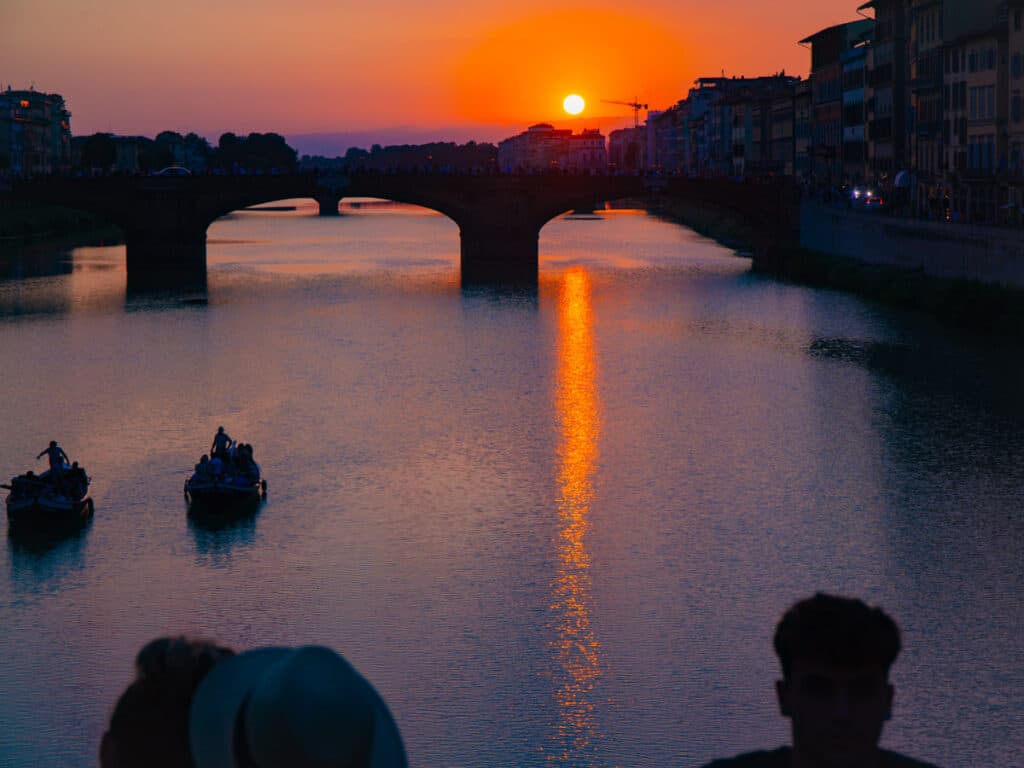
Ponte Vecchio is a popular spot for a Florence sunset, if you can’t make it up to the best sunset spot (see below)
Stop 5: Tuscan Food & Wine Tour
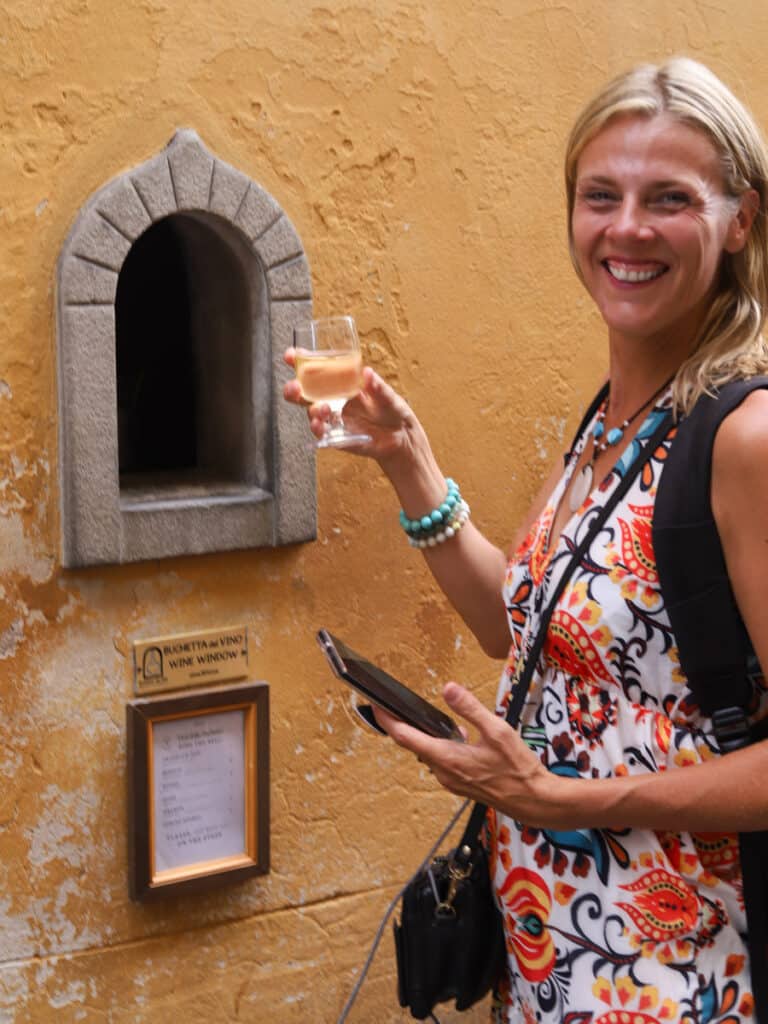
Many of the sites mentioned in this itinerary so far you’ll pass by on a Tuscan Food and Wine Tour in Oltrarno, but this tour is not all about the sites – it’s about the food!
You might be thinking that food in Florence is your typical Italian cuisine of pizzas, pasta, and gelato, and while you can find this, there are some dishes that are unique to this region.
For example, Florence, and Tuscany in general for that matter, is well known for its wine and cheeses. Pecorino cheese is a famous cheese from this region that’s made of ewes milk and is creamy and delicious.
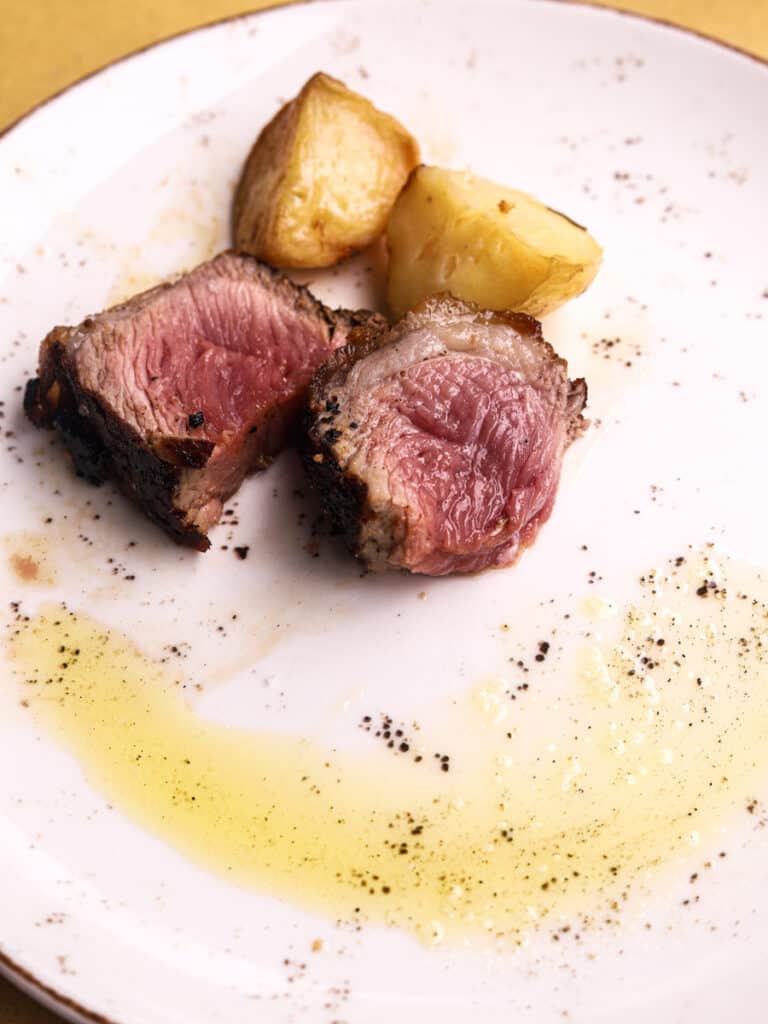
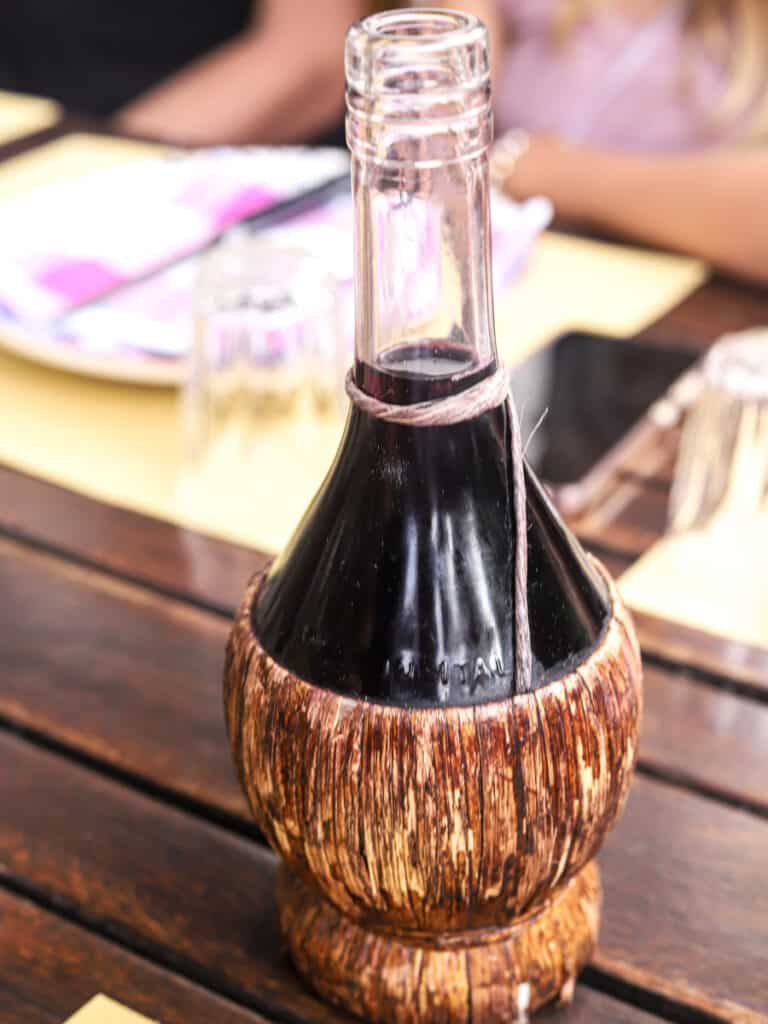
Another popular dish you should try is Florentine Steak, which is a staple dish in Florence. On a food and wine tour, you get to visit the best places in the city to try this dish, as well as learn about many other important cuisines in Florence.
Stop 6: Sunset from Piazzale Michelangelo
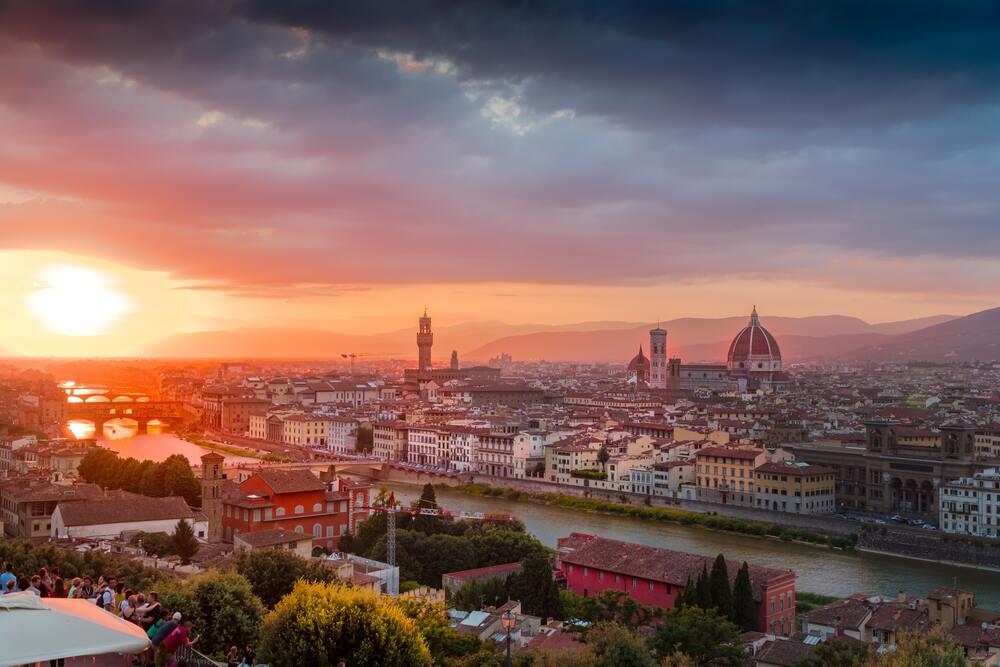
After your walking food tour, you’ll likely want to find a nice place to sit and admire the views. There’s no better view of Florence than from Piazzale Michelangelo.
The Piazzale Michelangelo is a square that sits atop of a hill overlooking the Oltrarno district.
The walk up isn’t long, but it’s steep and may be a challenge for those who are unfit.
Those who make the effort though will be rewarded with the most famous sweeping views of the whole city which has been replicated several times in postcards.
If you don’t want to walk up the hill, another great sunset spot is the Ponte Vecchio, which lights up in soft hues of gold and orange during golden hour.
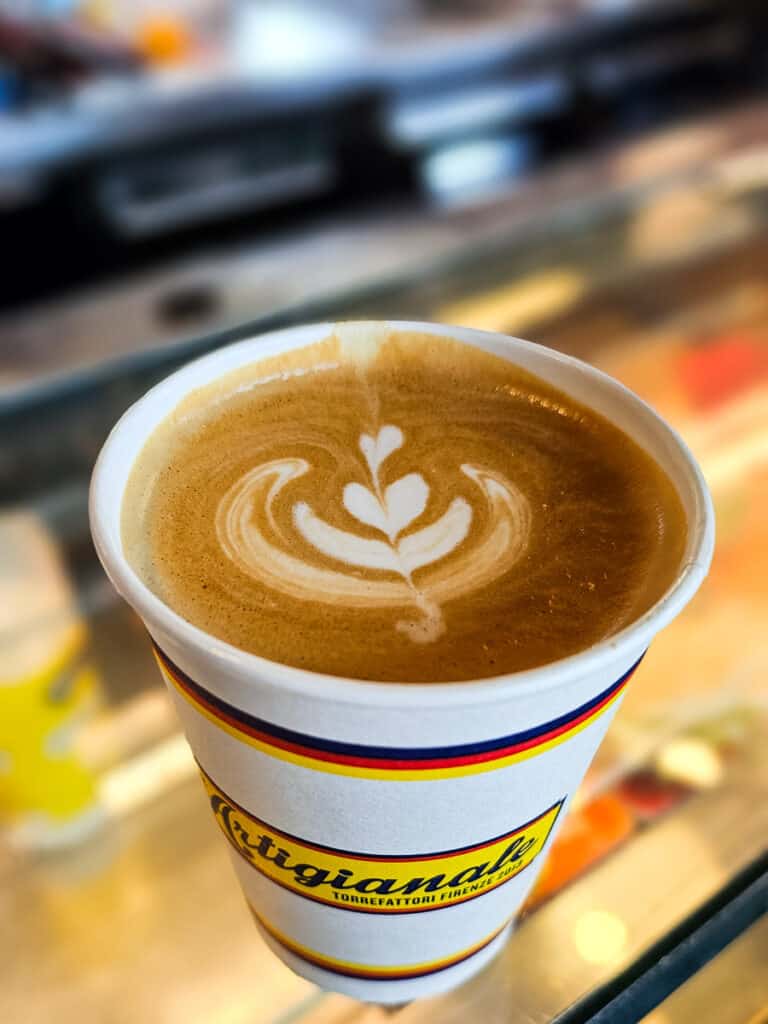

If you’re looking to add in some tasty treats while exploring Oltrarno, make these pit stops:
- Coffee at Ditta Artigianale Riva d’Arno. It was our favorite in Florence (third wave style)
- Gelato at Gelateria La Carraia. Our favorite gelato in on our Italy trip. Gelateria Artigianale La Sorbettiera is also good and has the original flavor. (Gelato originated in Florence)
- Wine from the Babae Wine Window. Very touristy but Florence unique and fun.
Day 2
Stop 1: Guided Walking Tour
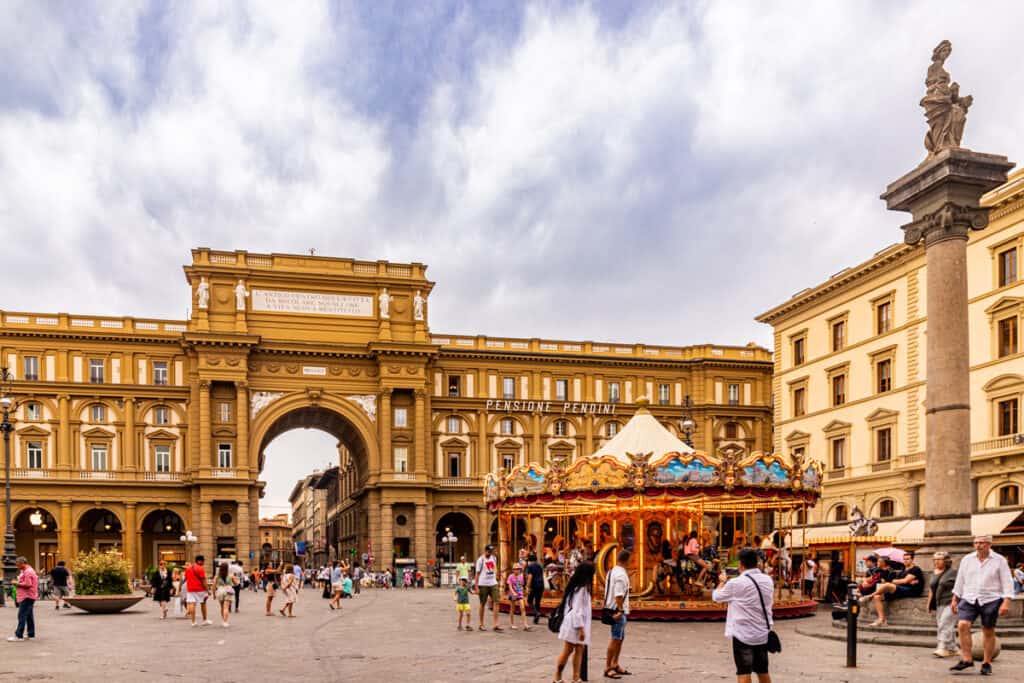
If you want to learn more about the history, way of life for the locals, and culture of Florence, then the best way to do that is on a Florence Guided Walking Tour.
Walking tours take you to see the highlights of the city in a “whistle-stop” fashion, but they also allow you to skip the line to see some of the most famous attractions.
They are ideal for those visiting for a short time and don’t have time to spare queuing. You get skip-the-line access to see The Statue of David at Accademia Gallery, and it includes a climb to the top of the Duomo.
Stop 2: Accademia Gallery
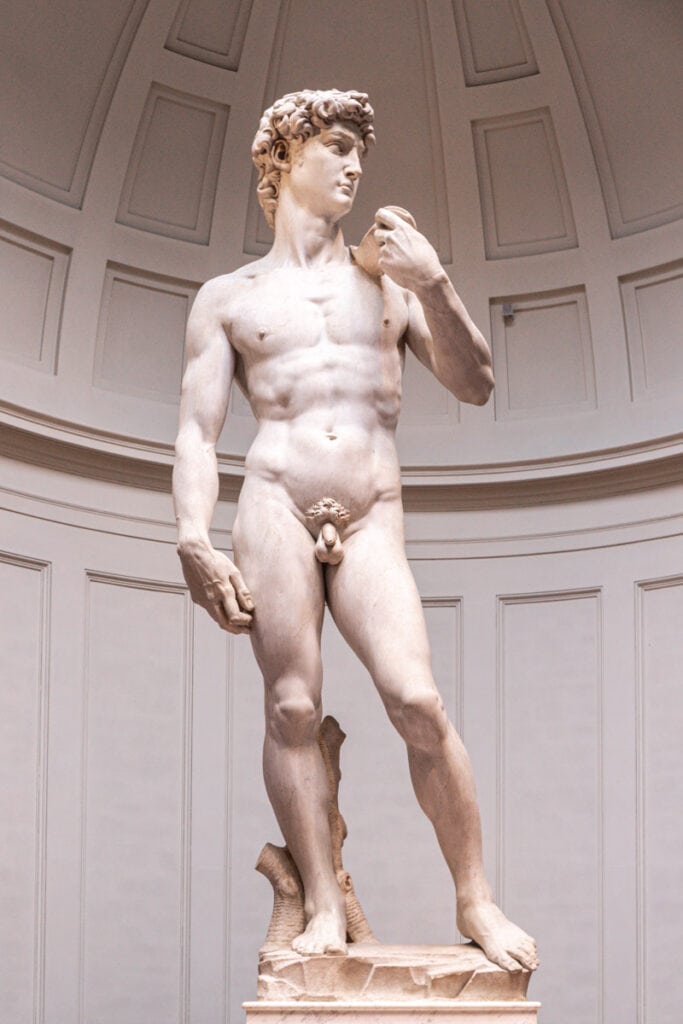
If you skip the walking tour mentioned earlier, then you should at least make sure you go and see the iconic Statue of David at Accademia Gallery – it’s possibly the world’s most famous statue and a must-see for anyone visiting Florence, whether you’re an art lover or not.
There is nothing quite like seeing the statue up close. Its size, for one thing, is impressive. I didn’t realize it was 17 feet tall (5.17 meters)!
Up close, you can see every muscle, every vein, every curve of the body – the attention to detail is nothing short of breathtaking. It’s easy to see why it’s one of the world’s most famous works of art.
Get your timed ticket for this attraction here. Even though we were on a guided tour with skip the line privileges, we had to wait in line for about 30 minutes. Without a timed ticket, you’ll be waiting much longer.
Stop 3: The Duomo, Baptistry & Bell Tower
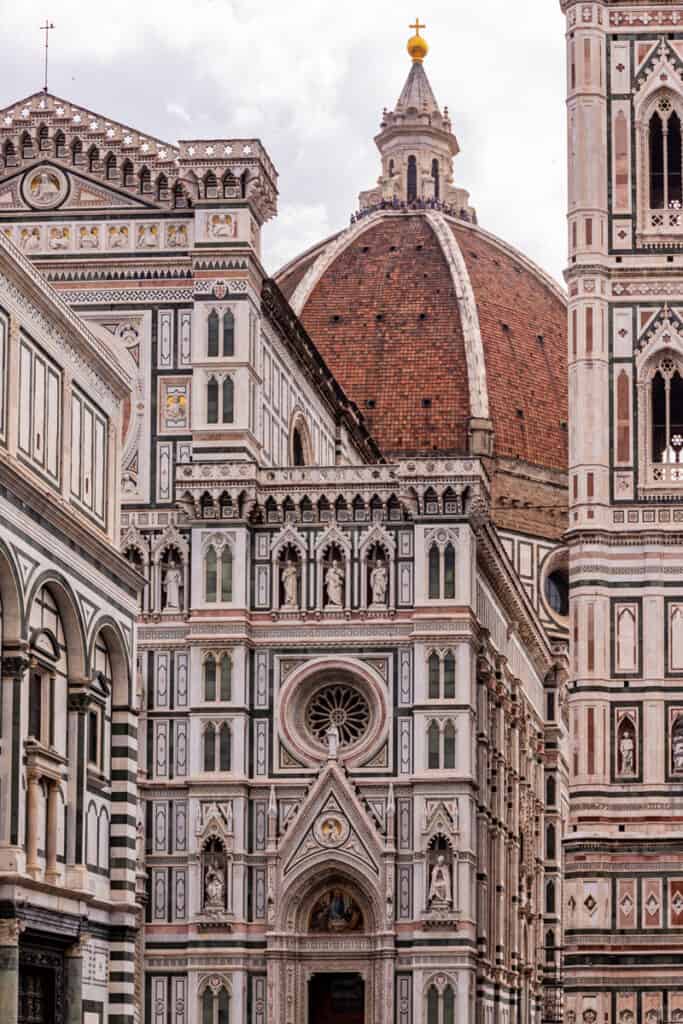
The most famous attraction in Florence is the Cathedral de Santa Maria del Fiore, more affectionately known as “The Duomo.”
This imposing structure dominates the skyline and would have been hard to miss if you followed the itinerary from yesterday and visited the Piazza Michaelangelo.
It was constructed in 1296 in a Gothic style but was only consecrated in 1436.
It’s most famous for its dome, known as Brunelleschi’s Dome, which has been decorated with fresco paintings and gilded details on the inside. If you opt to climb to the top of the Duomo you pass a balcony that gives you a closer look at the dome.
One of the main reasons to visit The Duomo is to climb the stairs to the top of the dome to see amazing city views. Fair warning though, if you’re afraid of heights, you’re not going to like this!
The viewing deck is quite skinny, and even though crowds are controlled, it does feel rather crowded up there. If climbing the dome is for you, then book your tickets in advance.
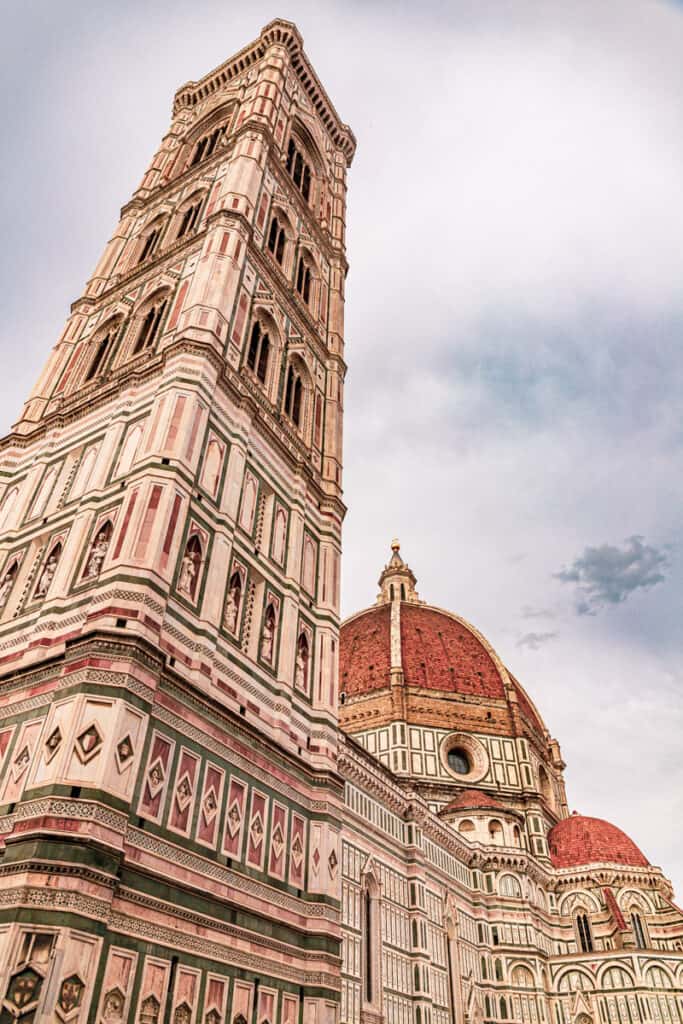
Alternatively, you can climb The Campanile, otherwise known as Giotto’s bell tower, just across the Piazza del Duomo. This requires you to hike up 414 stairs to get an incredible view, but if you have a fear of heights I found this viewpoint to be less scary to walk up.
However, if you only have time to climb one set of stairs, the view from the dome is much better.
Your entrance ticket to The Duomo also grants you access to The Baptistery, which dates back to the 11th century, making it one of the oldest buildings in Florence. It’s famous for its bronze doors, designed by Ghiberti’, and are affectionately called the “Gates of Paradise” (they are reproductions, the originals are in the Duomo Museum).
You can visit the Duomo for free, but lines can be long. If you want to skip these, then purchase a skip the line pass. Or arrive early instead and beat the lines that way!
Don’t forget to cover your shoulders and knees. If you forget, there is a hawker nearby ready to sell you a scarf!
Stop 4: Lunch at Central Markets
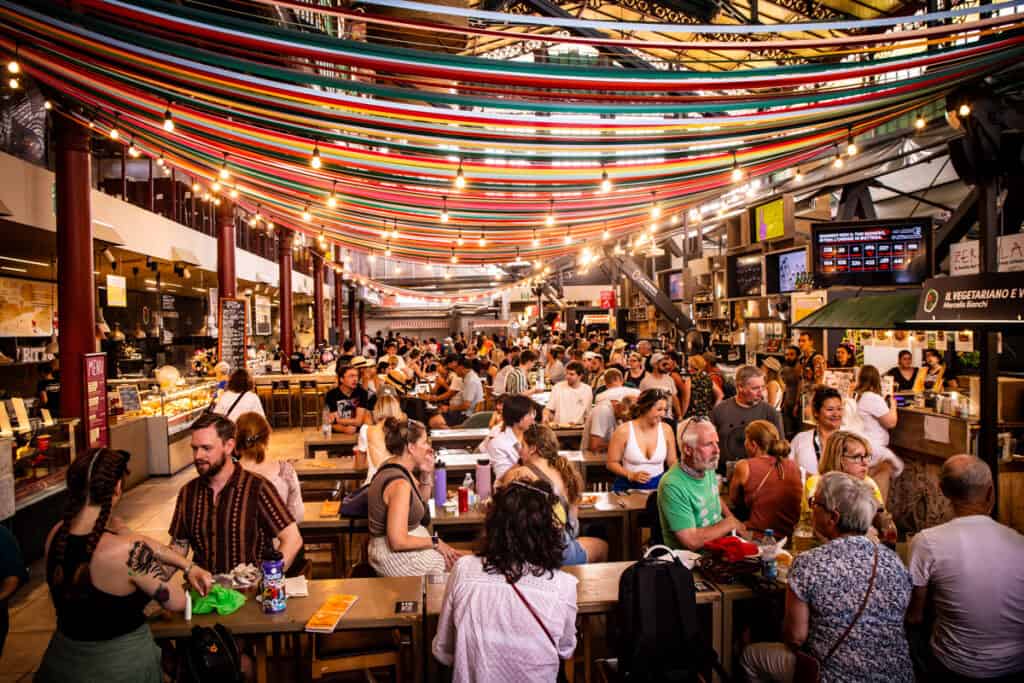
The Central Markets, also known as The Mercato Centrale, are the perfect place to stop for lunch. This historic market hall was built during the time of the Risanamento, the period when Florence was the capital of Italy in the late nineteenth century.
They are still used by the locals today who come here to shop for fresh produce of fish, meat, and vegetables.
On the top floor, there is a food court where you can find Tuscan and international dishes. The food court is made up of small, independently-owned restaurants, wine bars, and taprooms using fresh produce from the market to make excellent and affordable meals.

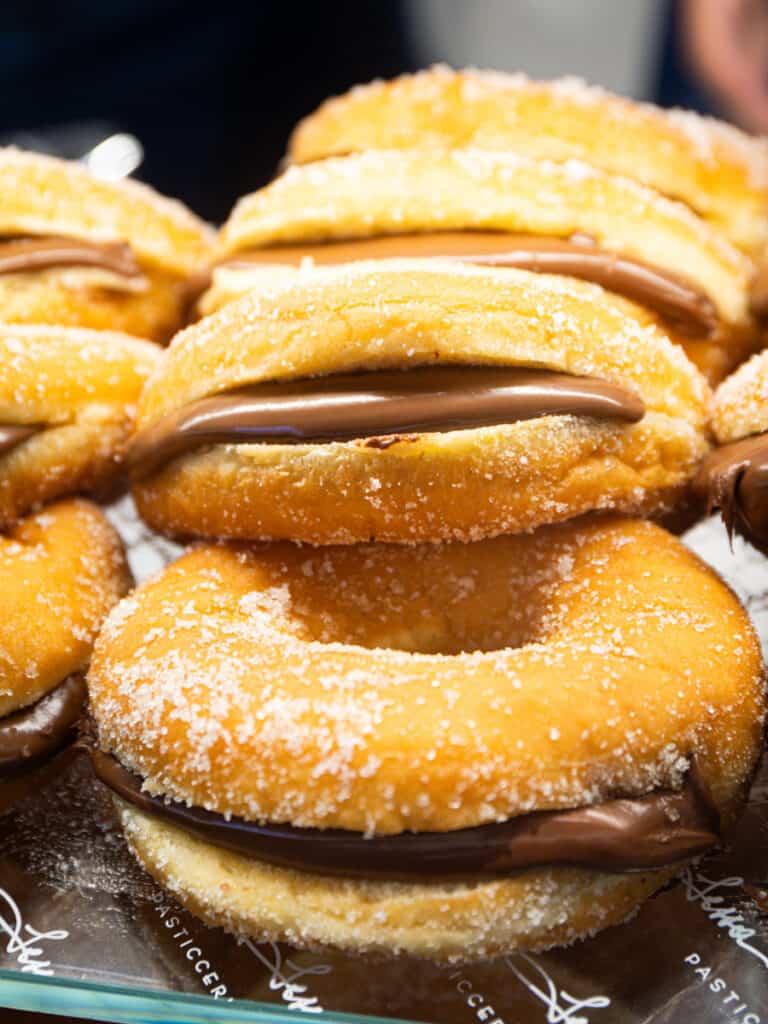
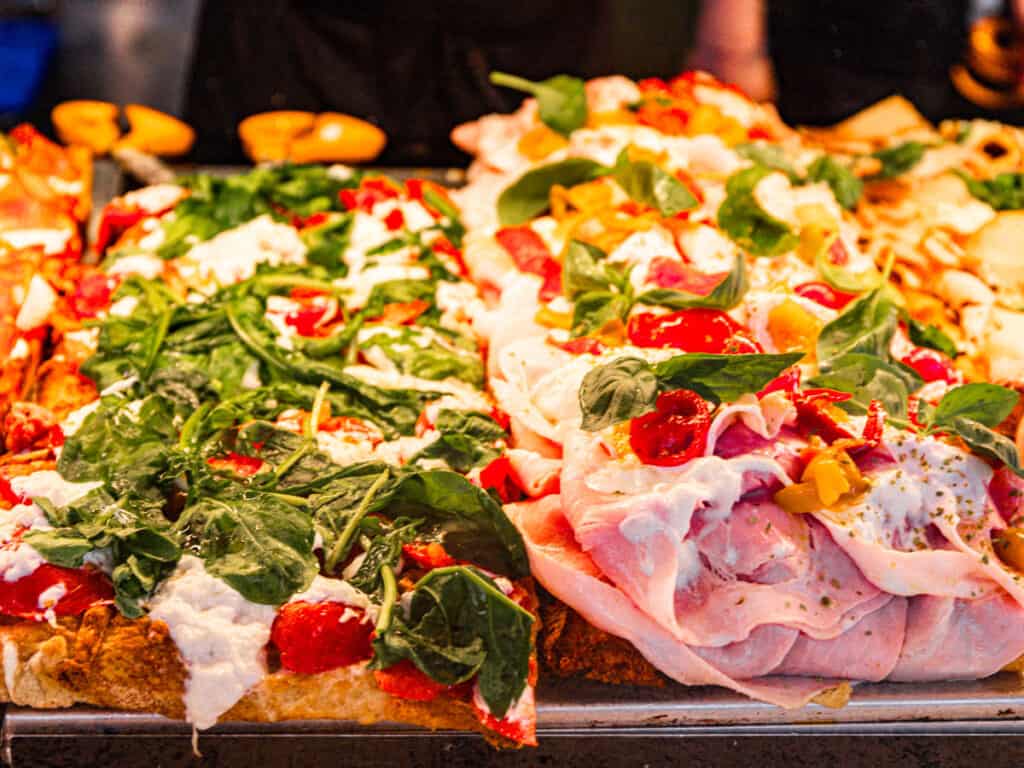
It’s a great place to grab a freshly made pizza or hearty sandwich. The food court is open from 10:00 am to midnight, so you can come back in the evening for dinner if you’re struggling to decide which restaurant to eat at.
We enjoyed our lunch here at the markets, but there wasn’t a lot of options if you’re gluten free. I was jealous I could not eat the cannolis and pastries tempting me from several stores. Savannah says, “deliziosa!”
Stop 5: Uffizi Gallery
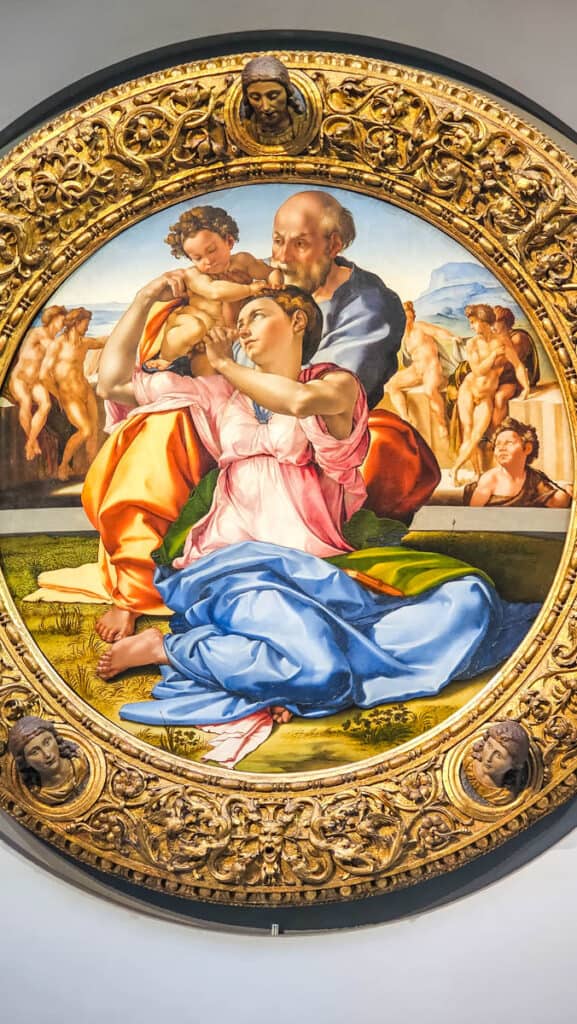
If you’re coming to Florence to experience its historic art scene, you cannot skip the Uffizi Gallery. It’s the most renowned gallery in the city and where you can see original pieces from the 14th-century Renaissance period’s greatest artists, including Raphael, Botticelli, Giotto, Michelangelo, Leonardo da Vinci, Caravaggio, and more.
Some of the most notable pieces in the gallery are ‘The Birth of Venus’ and ‘Primavera’ by Sandro Botticelli, ‘The Venus of Urbino’ by Titian, ‘Medusa’ by Caravaggio, and a self-portrait of Raphael.
I would say that it’s the most important place in Italy for art, closely followed by maybe the Sistine Chapel in The Vatican or The Galleria Borghese in Rome.
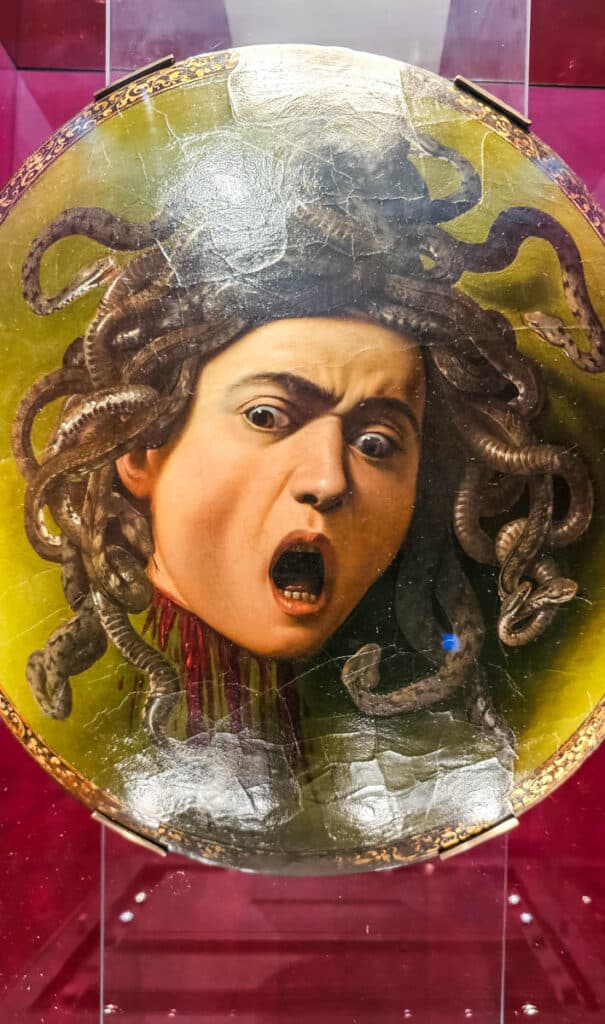
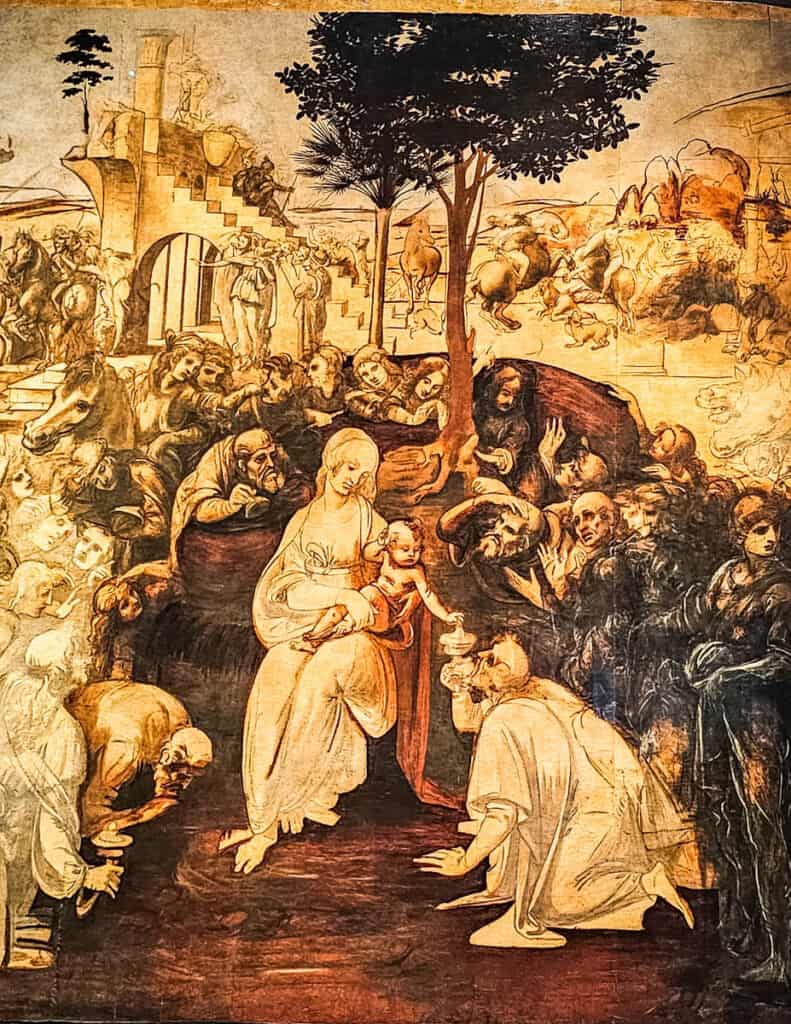
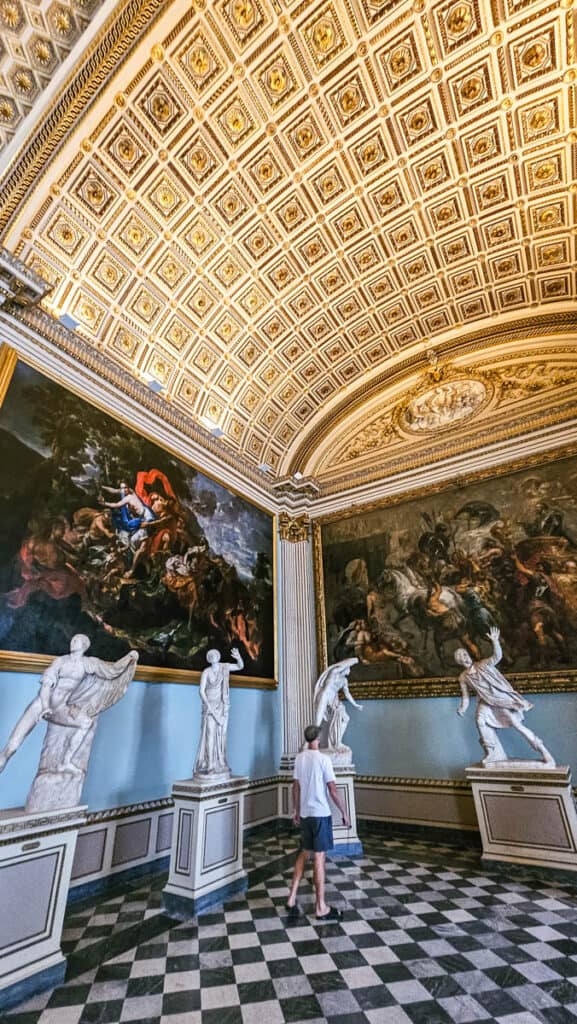
As this is the most famous art gallery in the city, you must book your entrance pass in advance to avoid the queues and make sure you can gain entry when you want to, as tickets are often sold out on the day.
The pass allows you to skip the line, but you still need to pick up your ticket from the counter.
I will admit, I am really only interested in modern art galleries, and even then I don’t do much of them, but I really enjoyed Uffizi. I wasn’t expecting to and only squeezed it into our itinerary as I knew how big and important it was. I’m happy to report, it was so worth it. For us a quick tour through (about an hour) was plenty.
Stop 6: Piazza della Signoria
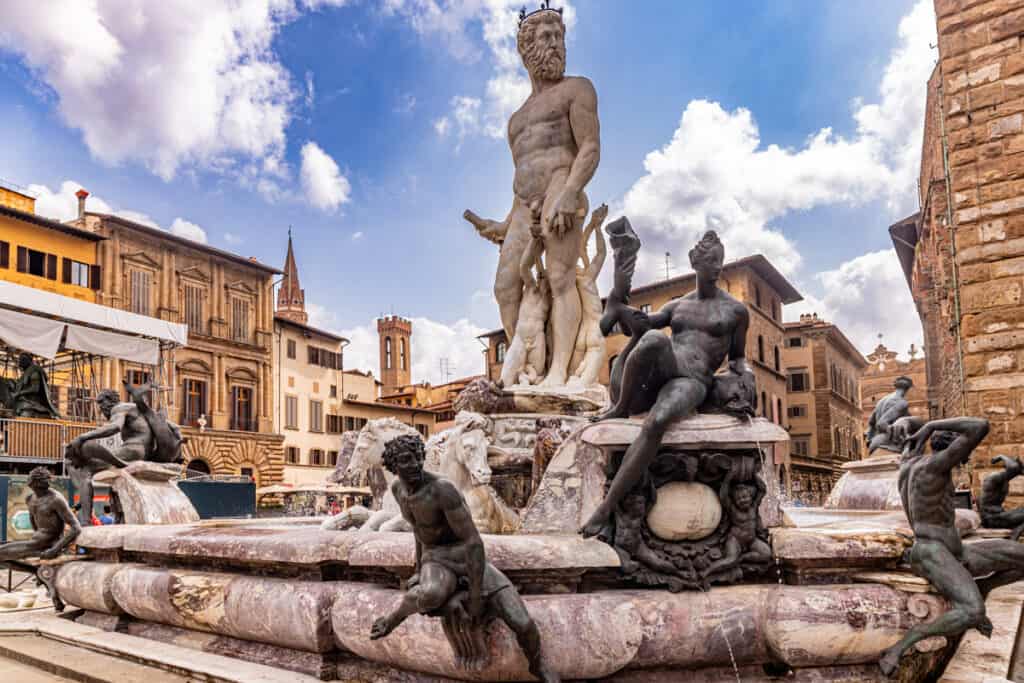
Piazza della Signoria is just outside the Uffizi Gallery and is a bustling square known for its beautiful statues and fountains.
The most famous of which is the Fountain of Neptune and a replica of the Statue of David.
Piazza della Signoria was once the political center of the city and was where the famous Bonfire of the Vanities was held.
It’s a great square to grab an espresso from one of the surrounding cafes and watch the tourists click away at their cameras.
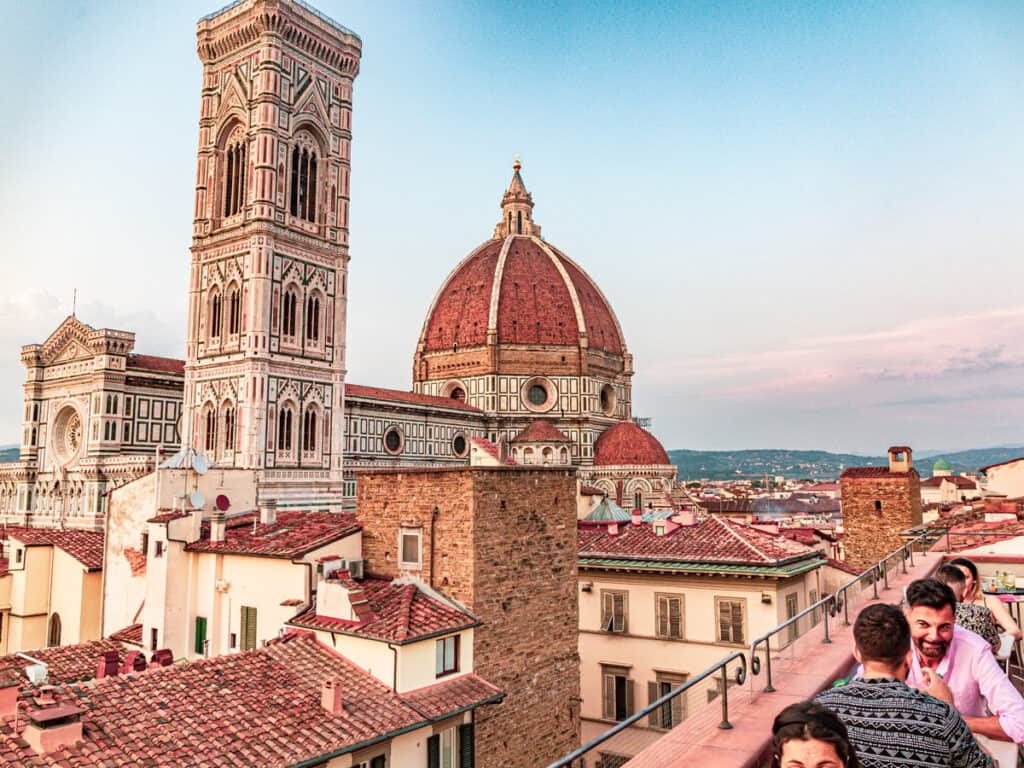
Some food and drink suggestions for this day.
- We loved the affordable and delicious dinner we had at Ostaria dei Centopoveri (popular with locals and students)
- Two rooftop bars with views you’ll want to see: La Terrazza Rooftop Bar (small and busy so get here early) and the View on Art Cocktail Bar (spectacular views of the Duomo. Great at sunset. Again -super busy and service was very slow (European style)
- Caffè Gilli oldest cafe in city famous for espressos
Map of This 2 Day Itinerary for Florence
To help you navigate this 2 day Florence itinerary, here is a map of the attractions mentioned in this guide. I’ve also included other places to eat and drink that I discovered in Florence during my research that I was interested in! You can save a copy of the map and then edit as you see fit for your Florence visit.
Getting Around Florence
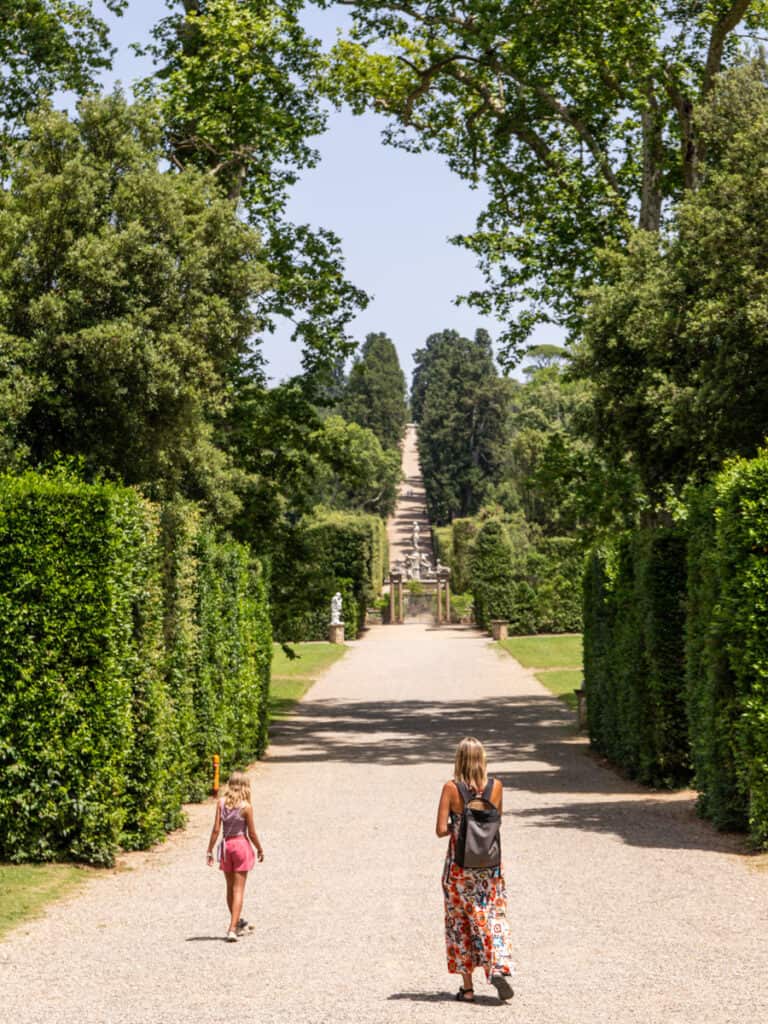
Getting around Florence is really easy as everything is within walking distance. Simply put on a comfortable pair of shoes and walk everywhere!
The roads are often cobbled and uneven though, so make sure you have flat shoes.
Otherwise, there is a bus system that connects the main city center to the suburban neighborhoods.
Where To Stay In Florence
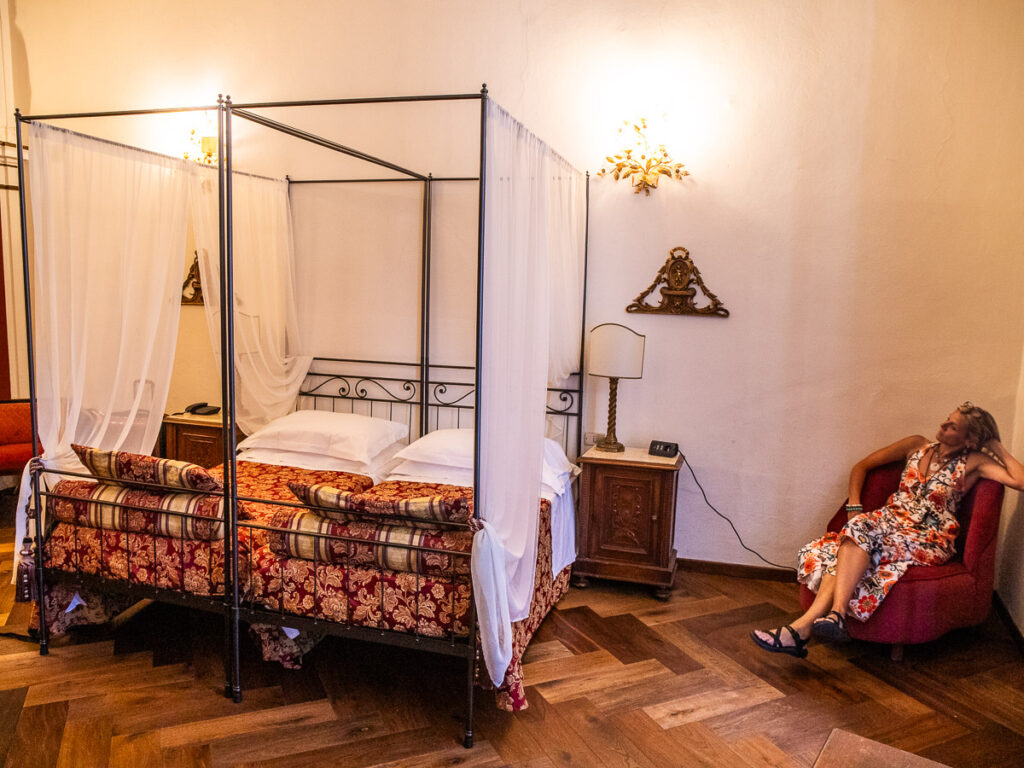
We really enjoyed our stay at Hotel Palazzo dal Borgo on the main tourist side of Florence which we booked using points. It had a great location, a separate room for the girls, a canopied bed, and included breakfast in their beautiful courtyard garden. See rates and availability. And you can see our Reel of it here.
Although, we didn’t stay there, I’d recommend people stay in the Oltrarno neighborhood when visiting Florence because it’s ideally located near the main attractions but without the noise and chaos of the main city center. We loved it there just like we did, Trastevere in Rome for similar reasons.
Friends have stayed at the Hotel David in Oltrarno and said it was an absolutely lovely hotel in a good location – close to the center but far enough so that you don’t get all the night-time noise.
The rooms are spacious and comfortable and come with WiFi, free parking, and a restaurant that has a gluten-free menu. It’s family-owned and operated, so you feel like they care for their guests and want to make you feel at home.
Best Time To Visit Florence
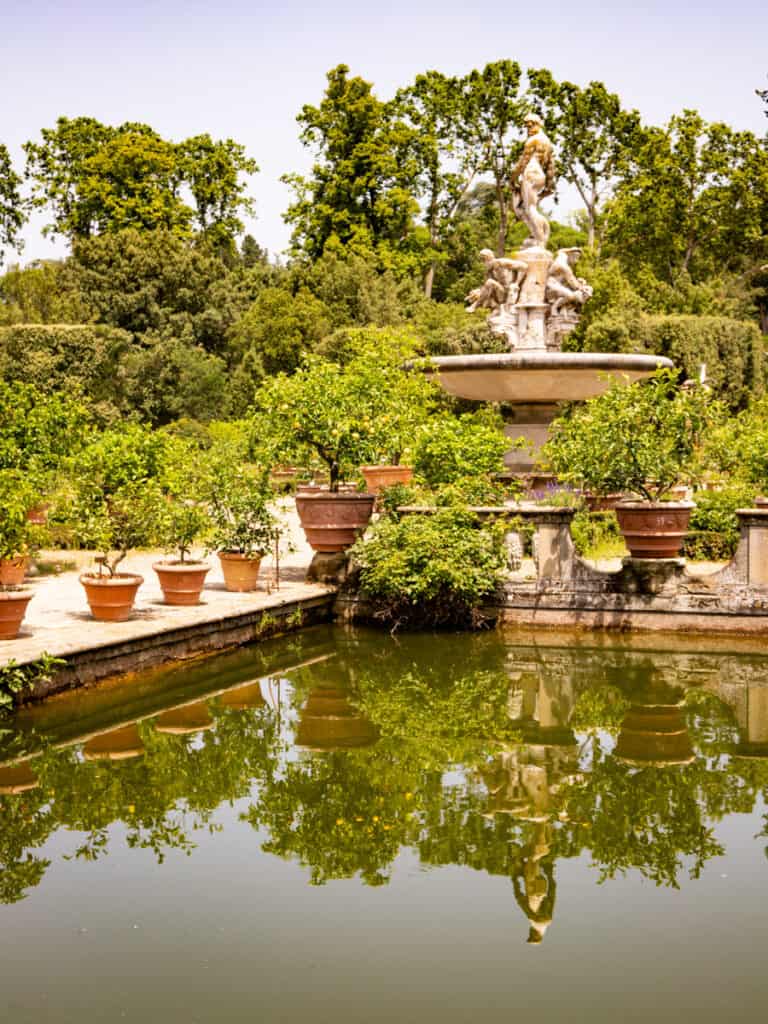
Florence is a city you can visit any time of the year since most of the attractions are indoors, however, if we had to pick a season, spring would be our favorite time to visit Florence. This is because the parks and gardens are awash in color as the flowers bloom and the grass shines in the soft due.
The summer is the peak season to visit Florence and is usually very hot and crowded.
The winter is a bit cold, but quiet, with fewer tourists visiting the city. The only downside to winter is that often it snows, which does add a certain beauty to the city, but makes flying in and out of the city a pain as flights are often canceled due to the snow.
Before You Go: Last Minute Tips For Visiting Florence
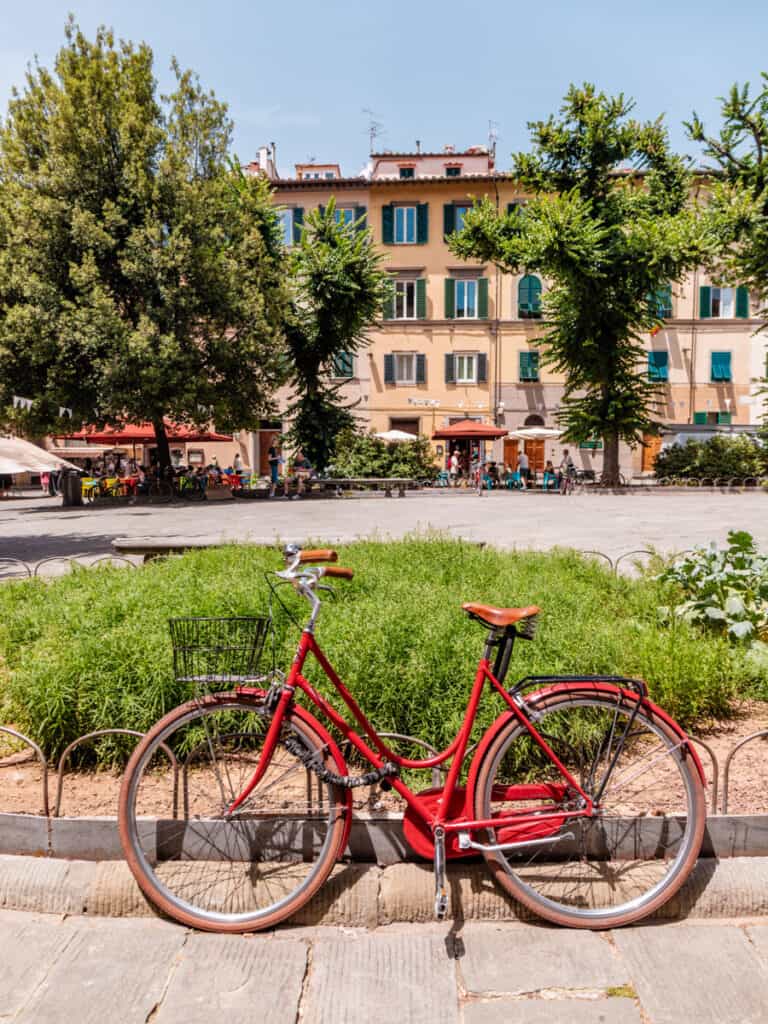
Lastly, before you go, I have just a few tips for visiting Florence to help you maximize your 2-day trip:
- Wear comfy shoes. Walking is the optimal way to get around Florence so make sure you have a good pair of walking shoes.
- Go rogue from this itinerary! One of the best ways to see a city is to simply walk around down random streets and experience the less-traveled paths.
- Book your museum tickets in advance. The queues for tickets can be long! Save yourself some time and book in advance.
- Try the wine! Don’t forget to stop into one (or a few) of the countless wine shops (enoteca) to find out what Tuscany is famous for!
- Don’t go too wild on Espresso. The coffee in Italy is a lot stronger than what you might be used to back home, so if you’re not big on caffeine then don’t go too wild on this.
- Download maps. It’s always a good idea to download an offline map, such as Google Maps or MapsMe in case your data is unreliable. You can download our map of this itinerary above.
- Book small group walking tours directly through our preferred tour companies: LivTours, Walks of Italy, and Devour Food Tours. All have been tested and approved by yTravel!
[ad_2]
Source link
